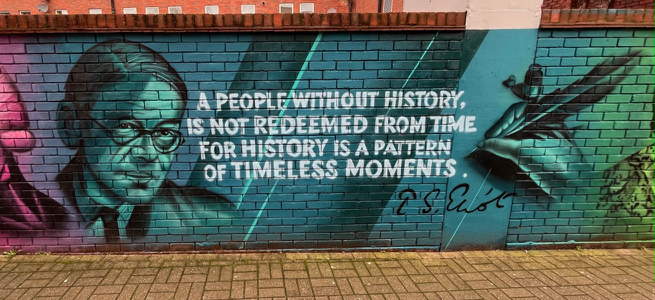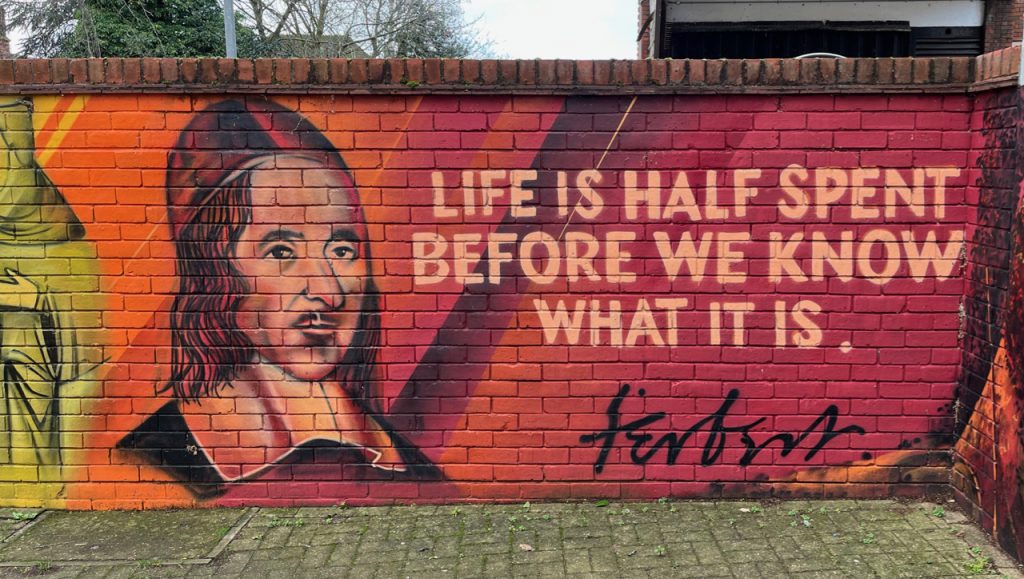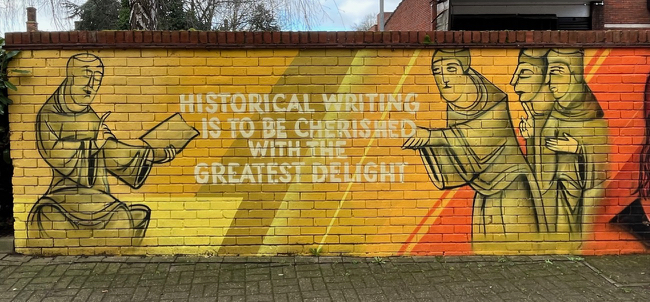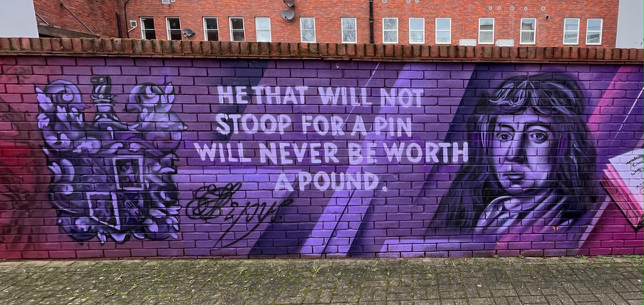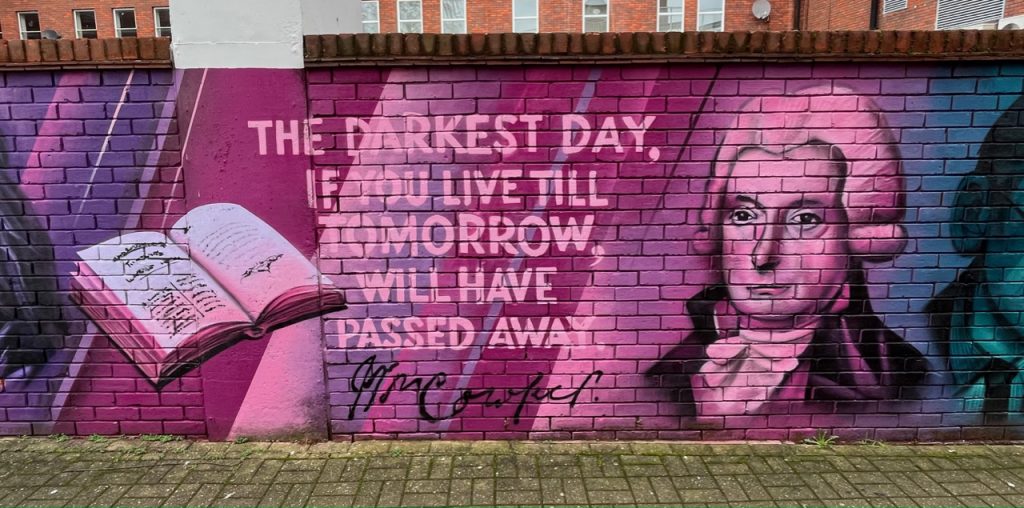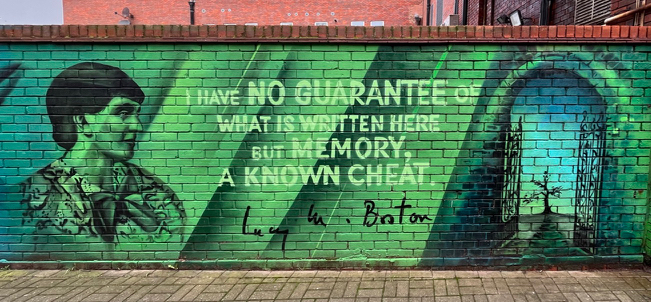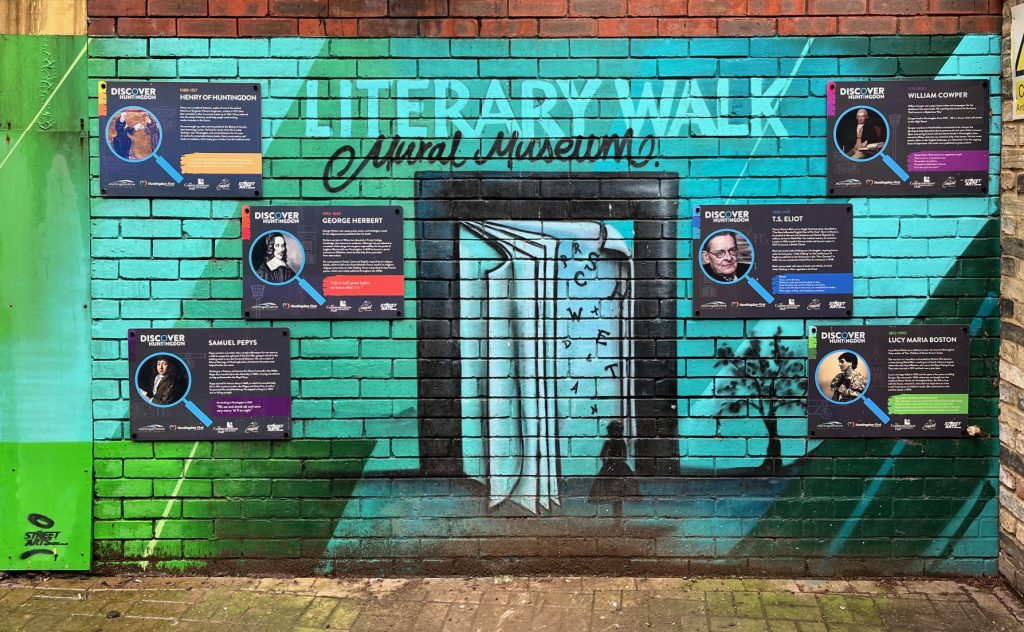Before 1974 Little Gidding was in the county of Huntingdonshire, whose county town is some 10 miles from Little Gidding at Huntingdon. The Ferrar family themselves lived at Huntingdon after John Ferrar’s descendants sold the manor at Little Gidding, and the house where they lived in Huntingdon is still called Ferrar House; several Ferrars are buried in the nearby churchyard.
At the other end of Huntingdon’s high street is a little alleyway called Literary Walk that has recently been painted with six murals of literary figures who have some connection with Huntingdon and Huntingdonshire. The six include the poet T S Eliot, whose connection is of course with Little Gidding, and a quotation from his poem of that name is part of the mural panel.
A final panel gives information about the six other panels. The details below about each panel are reproduced from this seventh panel.
Thomas Stearns Eliot was an Anglo-American poet, described as ‘the most influential English poet of his time’. Born in Missouri, he studied at Harvard, the Sorbonne and Oxford. Rejected for military service in World War I for medical reasons, he moved to London in 1916, mixed in literary circles and became a poet. In 1927 he became a British Subject.Eliot had visited Little Gidding near Huntingdon, inspiring him to write his final poem ‘Little Gidding’ on the timelessness of England, published as the final poem in the Four Quartets in 1942. He was awarded the Nobel Prize for Literature in 1948.
Eliot’s poems dealt with ideas of death and rebirth, of which ‘Little Gidding’ is often regarded as his finest.
Also featured is George Herbert, great friend of Nicholas Ferrar, and associated with Leighton Bromswold, another small Huntingdonshire village some five miles south of Little Gidding.
George Herbert was a poet, priest, orator, and theologian, noted for his religious poetry published after his death.Herbert was born in Wales, but educated at Trinity College, Cambridge, then became an academic. Although not yet ordained as a member of the clergy, he was given responsibility for the parish of Leighton Bromswold near Huntingdon. In 1629 he became a priest and moved to Wiltshire, where he died only three years later from tuberculosis.
He wrote poetry in Greek, Latin and English, inspired by his religious beliefs, which he left to his friend Nicholas Ferrar, head of an Anglican religious community at Little Gidding. Ferrar transcribed his late friend’s poems, which were widely published throughout the 1600s.
The other four panels are of the 11th-century Augustinian monk, Henry of Huntingdon; diarist Samuel Pepys, who lived at Brampton just outside Huntingdon and was schooled at Huntingdon; poet William Cowper who lived for a time in Huntingdon; and children’s writer Lucy Boston who lived at nearby Hemingford Grey.
Henry was a mediaeval historian, author of one of the earliest histories of England, Historia Anglorum, written in 1129, then later amended so that it covered events up to 1154. Henry believed that the study of history could help people avoid making similar mistakes in the future.He was brought up within the household of the Bishop of Lincoln, later becoming a priest. He lived for much of his life in Little Stukeley, near Huntingdon, and was Archdeacon for the area. As well as his remarkable history books, Henry wrote poetry and books on medicine, which today give a window into the mediaeval mind.
Pepys was born in London, then moved to Brampton for two years as a child to escape the upheaval of the Civil War, going to school in the building which is now the Cromwell Museum. He was a cousin of Edward Montagu of Hinchingbrooke, who became his patron and helped further his career.Working as a Treasury civil servant for Oliver Cromwell in the 1650s, Pepys then transferred to the Admiralty in 1660, carrying out reforms to help professionalise the Royal Navy.
Pepys started his famous diary in 1660, in which he recorded daily life in 17th-century London, the Plague and Great Fire, as well as his personal life and philandering. He stopped writing it in 1669 due to failing eyesight.
William Cowper was a poet, hymn writer and campaigner for the abolition of the slave trade. He is perhaps best known for the hymn ‘God moves in a mysterious way’.Cowper lived in Huntingdon from 1765–68 in a house which still stands on the High Street.
Cowper was born in Hertfordshire and trained to be a lawyer but developed deep depression due to pressure of work and a failed romance. Upon recovering he lived with the Unwin family in Huntingdon, then moved to Olney where he was invited to help write hymns. He also wrote poems, often on the English landscape, as a distraction from his ongoing bouts of depression. His works were published to great acclaim.
Lucy Maria Boston (née Wood) was a children’s writer who lived at Hemingford Grey, author of ‘The Children of Green Knowe’ books.She was born in Lancashire and studied at Oxford. She became a nurse during World War I, working in a French military hospital, where she met Harold Boston, who was in the Royal Flying Corps. They were married in 1917 and had a son a year later.
Lucy’s marriage failed in 1935 and she spent a few years travelling Europe. She returned in 1939, where her son bought her the mediaeval Manor House at Hemingford Grey. She fell in love with the house, restored it, and used it as inspiration to write a well-loved series of children’s books. She continued to write until her death in 1990.
A final panel gives brief information about the six other panels and assumes that the reader knows little about those depicted.
This article in local newspaper the Hunts Post reports on the creation of the murals.

